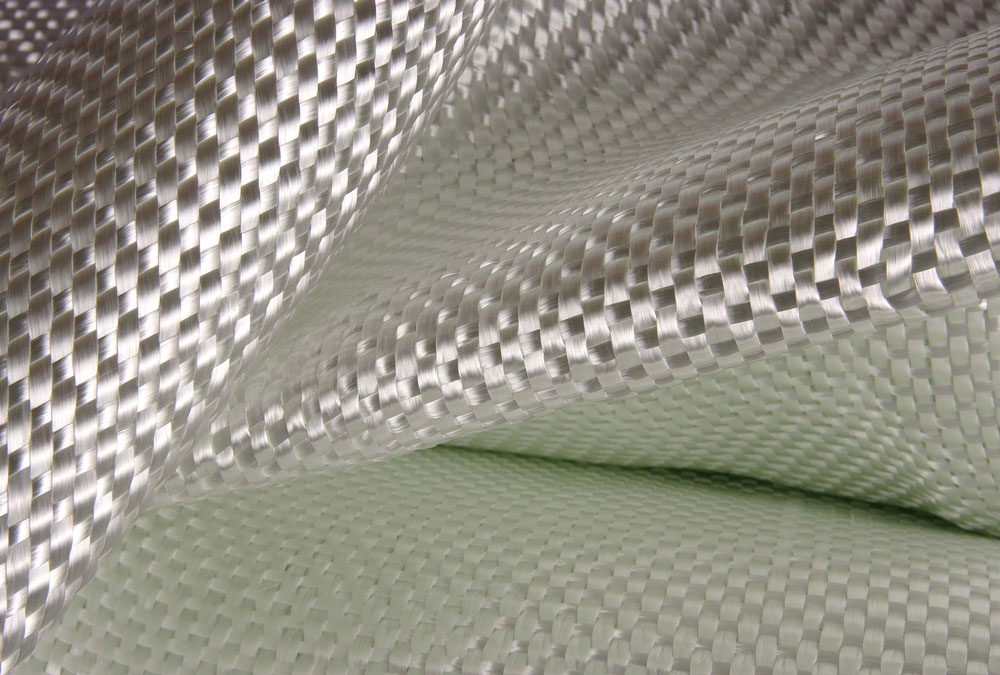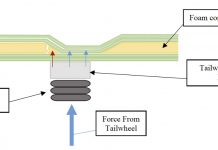Working with fiberglass and resin is as much art as it is science. As builders gain confidence and get used to working with fiberglass, they often come up with ideas that will help other builders avoid frustration as they “get their hands dirty.” Here are some tips our builders submitted.
 Proper Fiberglassing Techniques: to reduce weight and improve appearance of laminates, I would recommend using a product called PEEL PLY (WEST SYTEM #879-18) which can be obtained from West Systems. Applied over tapes and bulkhead laminates in conjunction with a bubble roller will result in less air entrapment and less resin in the lamination resulting in a higher glass to resin ratio and a superior lamination. A bubble roller is a must when trying to achieve proper glass to resin ratio.
Proper Fiberglassing Techniques: to reduce weight and improve appearance of laminates, I would recommend using a product called PEEL PLY (WEST SYTEM #879-18) which can be obtained from West Systems. Applied over tapes and bulkhead laminates in conjunction with a bubble roller will result in less air entrapment and less resin in the lamination resulting in a higher glass to resin ratio and a superior lamination. A bubble roller is a must when trying to achieve proper glass to resin ratio.
–Dan White
More on Peel Ply – I did my Bulkhead A, rudder pedal reinforcement, and fuselage reinforcements today. There has been some discussion of using plastic wrap. I used leftover Ceconcite material (Dacron) from the local EAA chapter. I used it as peel ply material but in large sheets. the layups are carried to the spot on the fuselage using the peel ply. each spot is wet out with a brush and the “patch” is applied like a band aid. Work out any bubbles and walk away. When the peel ply is removed later, you have a surface that matches the interior of the shells.
–John Steichen 5467
Resin Batches: I’m probably being a little paranoid here, but it occurred to me that I am keeping all these records of part numbers, lot numbers, etc. about my airplane, but nothing about the “batches” of resin which I am preparing for various steps in the building process. So, in my builders diary I have a numbering system for each batch of resin I make, including the amount of resin, amount of MEBK, and any additives (Q-cell, mill fiber, etc). Then, a comment on how the batch turned out (time to gel, etc). Finally, I take some of the extra batch and pour it into a small cup (the kind the fast food places set out for you to get ketchup and other condiments) and let it harden. Probably just keep these little plugs of hardened resin for several years and they toss them, but if there is ever a question about the resin in any part of my plane, maybe this will keep me from having to core a plug out of the plane itself.
–Tom Eggers
Electronic resin scale: To any of you out there who are still looking for a good scale for mixing resin and catalyst, I have found a good one. It’s a Sunbeam electronic digital scale that measures in lb. or grams up to four lb It will weigh pounds to the nearest quarter ounce and grams within 2 grams. Cost is $45. Can be ordered by phone from a place called Nasco in Ft. Atkinson, WI. Phone: 920-563-2446. Friend of mine building a Glasair is using this scale and likes it better than the two different kinds that broke already.
–Jim Hatzy #5582
Jim Hatzy recommended a scale available by mail order. To augment Jim’s post: For those not living to the right of the Mississippi, the phone number is 1-800-558-9595. The part number is WA12267H. The current price is $45.75, plus appropriate tax, shipping and handling. Thanks, Jim, for bringing this product to our attention.
–Scott Fifield, #5334
Easy vacuum bagging: Anyone interested in making their own vacuum bagged panels might be interested in the posting from the canard net.
–John Steichen 5467
A cheap method of vacuum bagging I make a lot of fuel tanks for other applications. Because of this and other projects, I often find myself needing a section of laminated flat panel of Clark foam or similar core and a layup on either side of glass. It takes just as much time to make a 2 foot by 4 foot panel as a 6″ by 6″ so I make some extra panels and set them aside. Bagging film or bags are expensive however so I developed a cheap way to have my cake and eat it too.
First I prepared a heavy section (half inch thick or better) of marine grade plywood (Marine grade doesn’t warp as readily). A high gloss sheet of Formica was glued to the surface. The panel cut to size and the edges of the Formica trimmed to the wood with a router. (Formica is brittle and breaks easily if snagged)
At the local hardware store, I purchased some plastic strips that are used to attach screens to porches and decks. These strips can be by any manufacturer, are usually about 2 inches wide and about three-eight’s inch thick. Regardless of brand or shape, they all share one important, common feature: they all have a round channel or grove that runs down the middle of one side. The channel is sized to accept the same round plastic spline (one-eighth or three-sixteenths inch diameter) used to attach fly screening. I cut four strips to lengths that will form a square or rectangle on the Formica covered board, typically 3 feet by 4 feet, depending on what size parts I make most often.
I then take doubled sided carpet tape and cover the bottom of each plastic strip with one continuous piece of tape. The protective film is then removed exposing the remaining adhesive and the plastic strip is glued in position to Formica surface of the bagging board. Place the remaining three strips the same way so you have an enclosed rectangle.
Now prepare your fiberglass layup as you would normally. Apply a good brand of mold release or carnauba wax to the exposed surface of the board and lay the prepared layup in place, peel ply face up if it has one. Apply any bleed material you think you might need (stuffing material from upholstery shops works great) Cover the plastic rectangle with a sheet of thin bagging film, without cutting it to size. Using that spline special tool that looks like a grooved pizza cutter. press a length of plastic spline through the film and into the channel. Be sure to pull the film as tight as you can as you work your way around the board. The less air you trap inside now and the less time your pump will spend evacuating the layup of air.
The corners where two plastic strips meet can sometimes pose a problem. I solved that by carefully folding the film at those corners and securing them with duct tape. All that’s left now is to make a small cross shaped incision in the film that will allow you to attach the vacuum fitting. Attach the hose from your vacuum pump and you are ready to go. On Larger layups requiring more than one fitting, I machined a manifold from a block of 6061 and attached it over head with a section of window sash chain and metal clips from a shower curtain rod. If done properly, the carpet tape will be sufficient to prevent leakage. I tested mine by pulling a high vacuum, turning off the pump, turning off the supply valve and noting the time. I went in the next day, pulled off a hose fitting and put my ear near the valve as I opened it. Whoosh!! Neat! On odd shapes, on large ones needing multiple suction points, I don’t cut the film as I don’t use the special film attachment device. Instead, I slip a piece of three-eighths metal or plastic tubing into a section of hose that goes to the previously discussed manifold. I position the tubing at one edge of the film with a tablespoon size wad of glazing putty, Plastelene from an arts and crafts store or similar material (Silicone caulk is messy and needlessly expensive). That seals the bottom of the tubing. I then tape the film to the table with duct tape. Common sense will guide you here.
If you are careful, you can use the same film over and over, something that’s appreciated given the high cost of autoclaving materials and bagging devices in the small volumes home builders buy. The plastic strips can usually be removed and repositioned to support different shapes and sizes. If you have a problem removing them from the Formica top, apply a little heat from a hair dryer to one end. Once you get it started, the rest should come off easily. Typically, a 3 foot by 5 foot example of this set up can be built for under thirty five dollars.
One word of caution: While 15 pounds of atmospheric pressure can really contribute significantly to the production of very light and strong parts, make certain they are flat to begin with. If they are not, and you apply that kind of pressure, THEY SOON WILL BE! Also: you can reduce the amount of epoxy by as much as fifty percent, depending on the speed with which your vacuum system can pull air. Don’t waste your time or money using canister vacuum cleaners. Besides being ineffective, the canister vacuums depend on a constant supply of moving air to cool the electric motors. Once the bag is empty of air, the motor will overheat and burn out or, if equipped with a thermal switch, shut off. Get the right tool for the right job. In the long run it’s cheaper.
Last: resist the temptation to remove any peel ply until you need the panel. The peel ply will keep the surface clean while it’s in storage. Have fun!
–The Canard Aviators’s Mailing list
Saving resin: I have been able to extend the life of promoted resin for months by flooding the the storage container (large wine jug-glass-) with an inert gas, nitrogen in this case, and keeping it in the garage refrigerator. With a generous application of vinyl electrical tape around the cork seal, no odor has escaped to the beer. So far the N2 prohibits condensation–no air, no water.
– Bill Wilson, #5278



